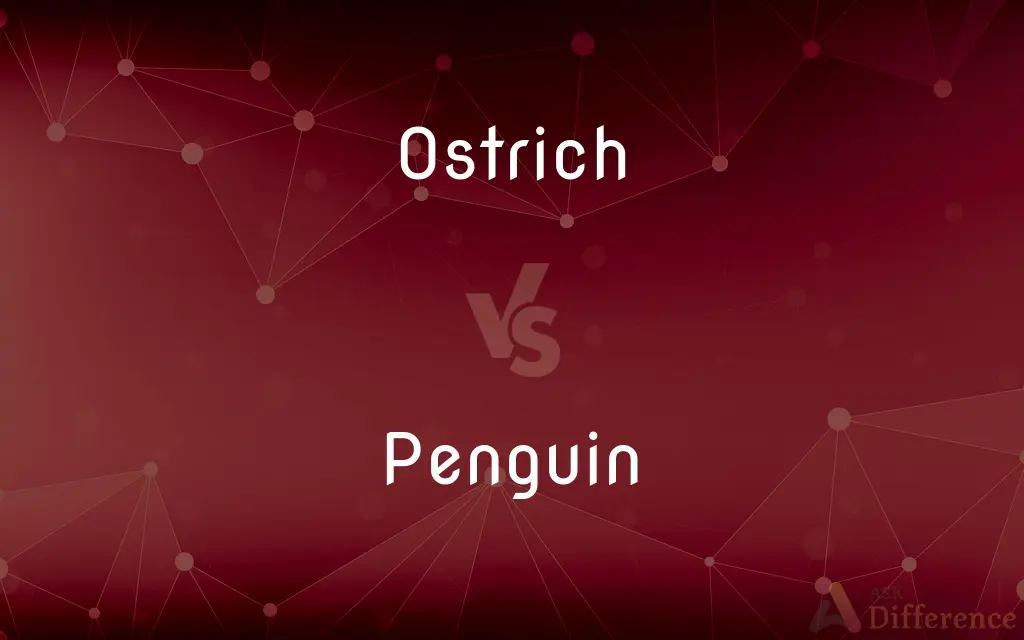Ostrich vs. Penguin — What's the Difference?
By Urooj Arif & Fiza Rafique — Updated on March 29, 2024
Ostriches are large, flightless birds native to Africa, known for their speed and size, whereas penguins are adapted to cold environments, primarily in the Southern Hemisphere, and are proficient swimmers.

Difference Between Ostrich and Penguin
Table of Contents
ADVERTISEMENT
Key Differences
Ostriches, inhabiting African savannas and deserts, are the world's largest birds, capable of reaching speeds up to 45 mph on land, making them the fastest two-legged animal. Penguins, on the other hand, are adapted to life in the water, with species spread across the Southern Hemisphere, from the Galápagos Islands near the equator to the icy shores of Antarctica, showcasing their versatility in various cold environments.
While ostriches are known for their long legs and necks, which aid in their remarkable speed and ability to cover large distances quickly, penguins have evolved with flippers instead of wings, optimized for swimming rather than flying, allowing them to maneuver effectively in their aquatic habitats. These physical adaptations highlight the significant differences in their lifestyles and survival strategies.
Ostriches lay the largest eggs of any living land animal, reflecting their size and reproductive strategy of investing heavily in a few, large offspring. Penguins, conversely, lay much smaller eggs, and their reproductive strategies often involve extensive parental care, with both parents sharing duties like incubating eggs and feeding their young in harsh environmental conditions.
Social behaviors also differ markedly; ostriches can be seen in groups that help in spotting predators and in communal nesting, where several females lay their eggs in the same nest guarded by a dominant male. Penguins are famously social animals, forming large colonies for breeding, which helps in protecting against predators and in withstanding the extreme cold of their habitats.
In terms of diet, ostriches are omnivores, feeding on a variety of plants and insects, which reflects their adaptation to the sparse vegetation and arid conditions of their environments. Penguins primarily feed on fish, krill, and squid, depending on their diving skills and aquatic life to find food, which also influences their distribution based on the availability of marine food sources.
ADVERTISEMENT
Comparison Chart
Size and Speed
World's largest bird, can run up to 45 mph.
Smaller, adapted to swimming.
Physical Adaptations
Long legs and necks for speed and vision.
Flippers for swimming, compact body.
Reproduction
Lays the largest eggs of any land animal.
Smaller eggs, extensive parental care.
Social Behavior
Forms groups, communal nesting.
Forms large colonies, highly social.
Diet
Omnivorous, eating plants and insects.
Primarily fish, krill, and squid.
Predation
Can use speed to escape predators.
Rely on water for escape, social for protection.
Compare with Definitions
Ostrich
Capable of living in groups for protection.
Ostriches sometimes form mixed herds with zebras and antelopes.
Penguin
A flightless bird adapted to aquatic life in the Southern Hemisphere.
Penguins use their flippers to swim efficiently underwater.
Ostrich
Lays the largest eggs of any land animal.
Ostrich eggs can weigh up to 1.4 kg each.
Penguin
Known for their social behavior and forming large colonies.
Emperor penguins gather in colonies of thousands to withstand Antarctic winters.
Ostrich
Omnivorous diet, including plants and insects.
The ostrich's diet varies widely, including seeds, leaves, and locusts.
Penguin
Exhibits extensive parental care, with both parents involved.
Penguin parents take turns incubating their eggs and feeding their chicks.
Ostrich
Characterized by long legs and neck.
The ostrich uses its long neck to scan for threats and food.
Penguin
Primarily feeds on aquatic organisms like fish and krill.
Penguins can dive deep to catch their prey.
Ostrich
A large, flightless bird native to Africa, known for its speed.
An ostrich can outrun most predators on the savanna.
Penguin
Lives in a variety of cold environments, from Antarctica to tropical islands.
The Galápagos penguin is the only species found north of the equator.
Ostrich
Struthio is a genus of birds in the order Struthioniformes, whose members are the ostriches. It is part of the infra-class Palaeognathae, a diverse group of flightless birds also known as ratites that includes the emus, rheas, and kiwis.
Penguin
Penguins (order Sphenisciformes , family Spheniscidae ) are a group of aquatic flightless birds. They live almost exclusively in the Southern Hemisphere, with only one species, the Galápagos penguin, found north of the Equator.
Ostrich
Either of two large, swift-running flightless birds (Struthio camelus or S. molybdophanes) of Africa, characterized by a long bare neck, small head, and two-toed feet. Ostriches are the largest living birds.
Penguin
Any of various stout, flightless aquatic birds of the family Spheniscidae, of the Southern Hemisphere, having flipperlike wings and webbed feet adapted for swimming and diving, short scalelike feathers, and white underparts with a dark back.
Ostrich
A rhea.
Penguin
(Obsolete) The great auk.
Ostrich
One who tries to avoid disagreeable situations by refusing to face them.
Penguin
Any of several flightless sea birds, of order Sphenisciformes, found in the Southern Hemisphere, marked by their usual upright stance, walking on short legs, and (generally) their stark black and white plumage.
Ostrich
(ornithology) A large flightless bird of the genus Struthio.
Penguin
An auk (sometimes especially a great auk), a bird of the Northern Hemisphere.
Ostrich
The most widespread species of the genus, known as the common ostrich (Struthio camelus).
Penguin
(slang) A nun (association through appearance, because of the often black-and-white habit).
Ostrich
(figurative) One who buries one's head in the sand instead of acknowledging problems.
Penguin
(juggling) A type of catch where the palm of the hand is facing towards the leg with the arm stretched downward, resembling the flipper of a penguin.
Ostrich
(golf) The hypothetical completion of a hole five strokes under par (a quintuple birdie, quadruple eagle, triple albatross, or double condor).
Penguin
A spiny bromeliad with egg-shaped fleshy fruit, Bromelia pinguin.
Ostrich
A person who refuses to face reality or recognize the truth (a reference to the popular notion that the ostrich hides from danger by burying its head in the sand)
Penguin
A member of the air force who does not fly aircraft.
Ostrich
Fast-running African flightless bird with two-toed feet; largest living bird
Penguin
Any bird of the order Impennes, or Ptilopteri. They are covered with short, thick feathers, almost scalelike on the wings, which are without true quills. They are unable to fly, but use their wings to aid in diving, in which they are very expert. See King penguin, under Jackass.
Penguin
The egg-shaped fleshy fruit of a West Indian plant (Bromelia Pinguin) of the Pineapple family; also, the plant itself, which has rigid, pointed, and spiny-toothed leaves, and is used for hedges.
Penguin
Short-legged flightless birds of cold southern especially Antarctic regions having webbed feet and wings modified as flippers
Common Curiosities
What's the main habitat difference between ostriches and penguins?
Ostriches live in African savannas and deserts, while penguins are found in aquatic environments across the Southern Hemisphere.
What are the reproductive strategies of ostriches compared to penguins?
Ostriches lay a few large eggs, relying on communal nesting for protection, whereas penguins have extensive parental care and form colonies for breeding.
Why are penguins not found in the Northern Hemisphere?
Penguins have evolved to live in the Southern Hemisphere's aquatic environments, with no historical population migration to the north.
How do the diets of ostriches and penguins reflect their environments?
Ostriches eat a variety of plants and insects, suitable for arid environments, while penguins feed on aquatic organisms, reflecting their aquatic habitats.
Can ostriches swim like penguins?
No, ostriches are not adapted for swimming like penguins, which are proficient swimmers.
What adaptations help penguins survive in cold environments?
Penguins have thick feathers, fat layers, and social habits like huddling together to withstand the cold.
Why do ostriches have such long legs and necks?
Their long legs and necks help ostriches run fast to escape predators and see over tall grasses for food and threats.
How do ostriches and penguins defend against predators?
Ostriches rely on their speed and size, while penguins use their aquatic environment and social groups for protection.
What is unique about penguin's swimming ability?
Penguins are highly adapted for swimming, with flippers and streamlined bodies, allowing them to "fly" underwater.
Are there any flightless birds like the ostrich in the Northern Hemisphere?
While the Northern Hemisphere has had flightless birds in the past, none are as large or similar in habitat as the ostrich.
How do ostriches and penguins contribute to their ecosystems?
Ostriches are key seed dispersers, while penguins help maintain healthy fish populations and serve as indicators of ocean health.
How does the social structure of penguins benefit them?
Penguin colonies help in breeding, protection from predators, and surviving in extremely cold temperatures.
Do ostriches have any natural predators?
Yes, lions, cheetahs, and hyenas can prey on ostriches, especially young or sick individuals.
Share Your Discovery

Previous Comparison
Connected vs. United
Next Comparison
Mange vs. ScabiesAuthor Spotlight
Written by
Urooj ArifUrooj is a skilled content writer at Ask Difference, known for her exceptional ability to simplify complex topics into engaging and informative content. With a passion for research and a flair for clear, concise writing, she consistently delivers articles that resonate with our diverse audience.
Co-written by
Fiza RafiqueFiza Rafique is a skilled content writer at AskDifference.com, where she meticulously refines and enhances written pieces. Drawing from her vast editorial expertise, Fiza ensures clarity, accuracy, and precision in every article. Passionate about language, she continually seeks to elevate the quality of content for readers worldwide.














































